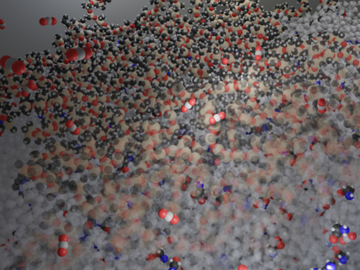
Filter News
News Type
News Topics
- (-) Big Data (6)
- (-) Computer Science (12)
- (-) Grid (3)
- (-) Machine Learning (6)
- (-) Quantum Science (2)
- 3-D Printing/Advanced Manufacturing (7)
- Advanced Reactors (1)
- Artificial Intelligence (14)
- Bioenergy (3)
- Biology (6)
- Biomedical (2)
- Biotechnology (3)
- Buildings (8)
- Chemical Sciences (14)
- Clean Water (4)
- Composites (5)
- Critical Materials (3)
- Emergency (1)
- Energy Storage (8)
- Environment (13)
- Exascale Computing (1)
- Fossil Energy (1)
- Frontier (1)
- Fusion (4)
- High-Performance Computing (10)
- Isotopes (4)
- ITER (1)
- Materials (7)
- Materials Science (7)
- Mathematics (2)
- Microelectronics (1)
- Molten Salt (1)
- National Security (2)
- Neutron Science (5)
- Nuclear Energy (3)
- Partnerships (5)
- Physics (1)
- Polymers (2)
- Quantum Computing (3)
- Security (1)
- Simulation (6)
- Statistics (1)
- Summit (2)
- Transportation (6)
Media Contacts

A study by more than a dozen scientists at the Department of Energy’s Oak Ridge National Laboratory examines potential strategies to integrate quantum computing with the world’s most powerful supercomputing systems in the pursuit of science.

Researchers at ORNL have demonstrated that small molecular tweaks to surfaces can improve absorption technology for direct air capture of carbon dioxide. The team added a charged polymer layer to an amino acid solution, and then, through spectroscopy and simulation, found that the charged layer can hold amino acids at its surface.

Prasanna Balaprakash, director of AI programs at the Department of Energy’s Oak Ridge National Laboratory, has been appointed to Tennessee’s Artificial Intelligence Advisory Council.

To better predict long-term flooding risk, scientists at the Department of Energy’s Oak Ridge National Laboratory developed a 3D modeling framework that captures the complex dynamics of water as it flows across the landscape. The framework seeks to provide valuable insights into which communities are most vulnerable as the climate changes, and was developed for a project that’s assessing climate risk and mitigation pathways for an urban area along the Southeast Texas coast.

Researchers at Oak Ridge National Laboratory have opened a new virtual library where visitors can check out waveforms instead of books. So far, more than 350 users worldwide have utilized the library, which provides vital understanding of an increasingly complex grid.

Oak Ridge National Laboratory scientists have developed a method leveraging artificial intelligence to accelerate the identification of environmentally friendly solvents for industrial carbon capture, biomass processing, rechargeable batteries and other applications.

Researchers at Oak Ridge National Laboratory have developed free data sets to estimate how much energy any building in the contiguous U.S. will use in 2100. These data sets provide planners a way to anticipate future energy needs as the climate changes.

ORNL scientists develop a sample holder that tumbles powdered photochemical materials within a neutron beamline — exposing more of the material to light for increased photo-activation and better photochemistry data capture.

Researchers at ORNL are developing battery technologies to fight climate change in two ways, by expanding the use of renewable energy and capturing airborne carbon dioxide.

Scientists at ORNL completed a study of how well vegetation survived extreme heat events in both urban and rural communities across the country in recent years. The analysis informs pathways for climate mitigation, including ways to reduce the effect of urban heat islands.


